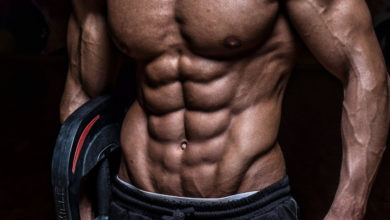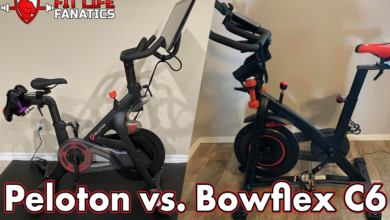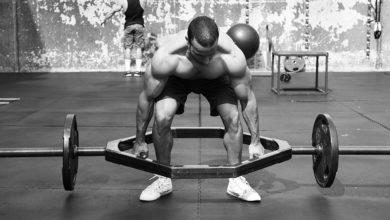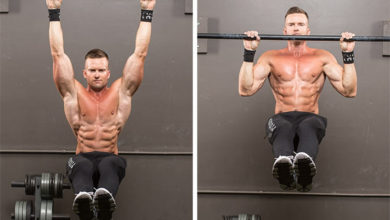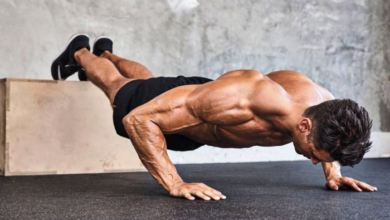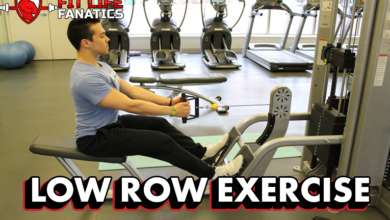Dumbbell Floor Press: How To Exercise Guide (Video Demonstration), Benefits, Muscles Worked, Mistakes, and Alternative Exercises
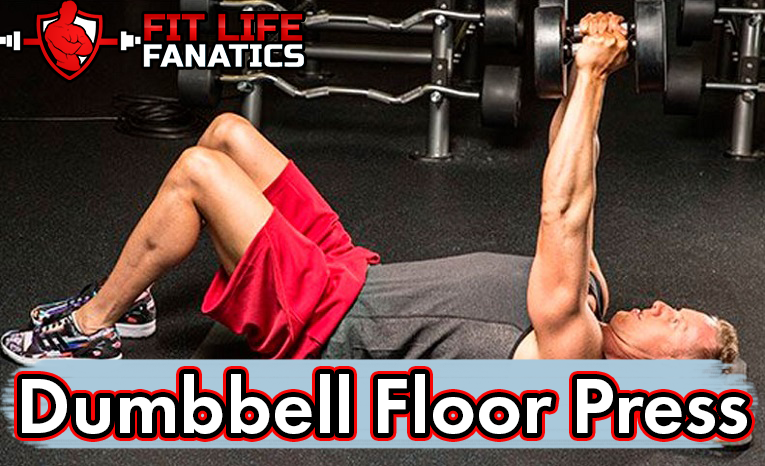
The dumbbell floor press can be very deceiving at first glance. Many people see it as a watered-down version of the regular bench press.
To be honest, I can understand why some people might see it that way. The shorter range of motion with the absence of a bench gives off that impression. Not to mention that you need to lie on the floor for this exercise.
However, the dumbbell floor press has been a popular workout among bodybuilders as well as powerlifters well before the traditional bench press technique was a thing. It can be used as a stepping stone to coming up with other chest exercises. It’s also known as an excellent tricep workout.
I’m here today to show you the light as looks can be deceiving, and there is no better example of it than with the dumbbell floor press.
Overview of the Dumbbell Floor Press
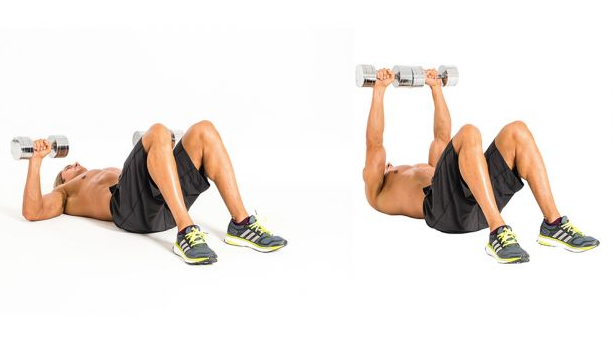
History
You can think of dumbbell floor press work as a close relative of the bench press. It is an upper-body exercise with a limited range of motion than a regular bench press. This is especially good for people who have shoulder joint injuries or other limitations.
You’ll most commonly see floor presses being used in powerlifting and as an accessory lift in CrossFit. Since the floor will remove your legs out of the exercise, you’ll only develop strength in your upper body.
Floor presses can be done with a pair of budget dumbbells, a barbell of the right weight, or kettlebells – you just need to use the right press technique to make the dumbbell floor press effective. And that shouldn’t be a problem, as there is a catalog of dumbbell floor press instructions all over the internet.
They have been around ever since the 1800s and are still going strong as a popular upper body workout to this day.
Skill Level Required – Beginner
The dumbbell floor press is suitable for anyone, from beginners to advanced lifters and bodybuilders.
Is It Hard Exercise for Beginners to Learn?
Learning the dumbbell floor press is easy as pie, but make sure someone’s spotting you the first time to avoid injury. All you need is the weights. The best place to get weights and dumbbells is going to be at your local sporting goods store or here on amazon.
Finding a pair of cheap dumbbells can be quite hard though. Here are the ones that I use.
How to Do the Dumbbell Floor Press
Step 1:
Kick off the exercise in a sitting position. Then, grab the weights with your palms on top. Then, curl the weights to your chests and make sure your arms are bent. You should also avoid touching your body directly and make sure your legs are extended in a straight line.
Step 2:
Once you’ve gotten comfortable with the weights at your chest, lie down slowly and keep your whole body in a straight line. Your back should always remain in direct contact with the ground.
Step 3:
Now that you’re settled into your position, bend your knees so that your legs make a triangle shape with the ground then follow these steps:
- Keep your arms straight at the top while you raise the two dumbbells. Make sure your palms are facing towards your legs and knees.
- Breathe in and lower your elbows, all while keeping them near your side. The motion needs to be slowed and controlled, and make sure your elbows touch the floor.
- Resume the starting position exhale repeat
Don’t forget to rotate your wrists while pushing the weights upwards toward the ceiling.
Here is a video showcasing these steps:
Dumbbell Floor Press Video Illustration
Tips
- Don’t entirely lock out your elbows to maintain more tension through the pecs.
- To keep your elbows in a neutral position, slightly tilt the weights at a 45-degree angle.*
- Don’t let the two dumbbells touch at the top of each rep. It will cause you to lose stability and maybe even harm yourself.
- Squeezing the dumbbells as tight as possible will promote greater shoulder stability. It’s a phenomenon known as “irradiation.”
- If you bounce your elbows off the floor at the bottom of a rep, you’ll risk injuring yourself and ending up with serious elbow pain due to the compressive forces that would be generated between the weights and the floor.
- Make sure you maintain some tensions in your abs for better posture.
How to Make the Floor Press Easier
If you’re having trouble with the floor press exercises, just use lighter dumbbells, such as a pair of neoprene women’s dumbbells.
How to Make the Floor Press Harder
If you want to make things more challenging, the simplest way is to use heavier dumbbells.
You can also add a glute bridge. Instead of starting the exercise with your bottom on the floor, raise your hips to make a straight line from your shoulders to your knees. Next, try to match the motion of your arms with your butt – it’s also one of the best ways to tone and build a jiggly butt. As you lower your upper arms, follow the same motion with your bottom. As you press the weights back to the starting position, raise your bottom back into a glute bridge.
How to Add This Exercise to Your Workout Routine
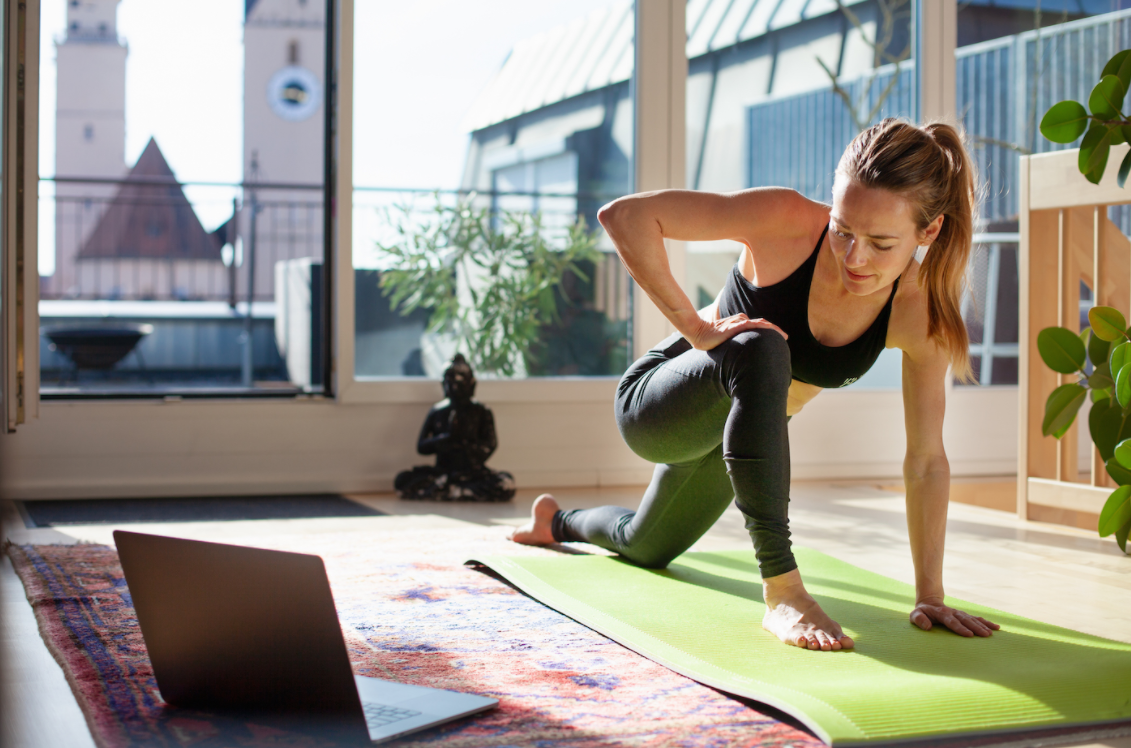
Dumbbells floor presses are best used as a smaller part of a whole workout session. Think of it as a complementary exercise that goes with other upper body exercises. I usually pair it with tricep extensions to truly target and build the back of my arms.
Even though you usually won’t be able to floor press as much as you can bench, you’ll still be able to do much better with a floor press than you otherwise would via an overhead extension.
An exercise that can come in handy
We’ve all been at a certain stage where it feels like we can’t get any better. It feels like being stuck in a rut where you can’t improve. Well, you can use the floor press to help yourself get out of that rut.
Even since I’ve incorporated it into my chest routine, I was able to lift heavier weights and expose myself to significantly less strain as well. The hammer strength chest press is also a great alternative to the bench press because of the partial range of motion and because it is controlled.
While the bench press involves a longer or full range of motion, the floor press provides a welcome change of pace and a great contrast to the bench press. It can be unforgiving and explosive since you won’t be able to cheat your way out of it or make it easier for yourself.
You’ll have to start from scratch with each rep, and your body will get much stronger for it and benefit with muscle growth to be proud of too. However, you’ll get quickly drained and exhausted if you’re not used to this sort of raw, unassisted exercise. It uses stabilizer muscles which can be very strenuous when lifting heavy.
Dumbbell Floor Press: Muscles Worked

The floor press is an excellent exercise that works your shoulders, chest, forearms, triceps, and even biceps, which can also be targetted with other workouts like the dumbbell pullover exercise for tricpes, the seated tricep press for shoulders, and the australian pull-ups for chest muscle mass. They are amazing for muscle growth in your upper body.
Furthermore, since the floor press technique have a partial range of motion, you’ll be able to add 5 or 10 percent more weight than you would be able to in a 1-rep max bench press. You’ll also be able to notice a big improvement when it comes to triceps and pectorals hypertrophy.
Floor pressing can also work well in a strength training program as a standalone exercise.
One last thing I should add is that floor press technique can even work your core, glutes, and hips.
Dumbbell Floor Press Variations
Barbell Floor Press

In this variation, first, you need to lie down on the floor under your bar. Then, with your hands being shoulder-width apart, grasp the bar with an overhand grip.
As for your legs, you can either have them bent, in which case your must plant your feet flat on the floor, or you can have them extended. I use the latter position since it ensures that the lift will only be powered by your upper body.
What’s next
Once you’re under a squat rack or power rack ( a power rack with lat pulldown is a great option if you want to mix things up slightly,) take the bar off and hold it right above you. If you’re using a grounded bar, you’ll probably need someone to help you get it off the ground whenever you start a set.
Once your arms have reached a full extension with the bar right above your chest, lower it slowly until your upper arms reach the ground, then quickly press it back up in a burst of energy.
Bridge Press
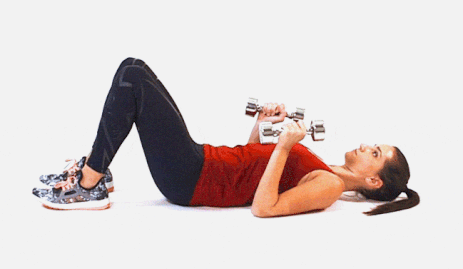
You can perform this variation with either a barbell or dumbbells. It aims to incorporate your hamstrings, glutes, and core to the workout.
As you press the weight, follow the motion with your hips as you would do in a glute bridge.
Once your arms are in full extension and your hips are up in a way that you’re your body is perfectly aligned from head to knees, pause for a short moment and slowly lower your body back to the start.
If you want to incorporate your core more into the exercise, you can hold the bridge during the whole set. This will make things much more challenging and would work your pecs more.
Benefits of Dumbbell Floor Press
Develops Jacked Arms

The dumbbell floor press is an exercise that purely involves the upper body. Since your legs remain still throughout the whole set, your upper body, and specifically your arms and pecs, will be taking center stage and doing most of the work. This is why I usually recommend this exercise to anyone who wants muscle growth and pack on size to their arms. The other workout that lets you work your arms is the rear delt fly, which is also good for shoulders and chest.
Builds Strength

Your arms aren’t the only thing that will be getting jacked. Your whole body will get stronger, and due to the more explosive nature of the exercise, you’ll find that you’ll be building up strength much more efficiently than you would with a bench press.
Impressive, huh?
Another thing that makes the dumbbell floor press such a great exercise for building strength is the fact that the range of motion is shorter than that of a bench press. What this means is that it’s usually easier to work with heavier weights.
Improves Your Lockout
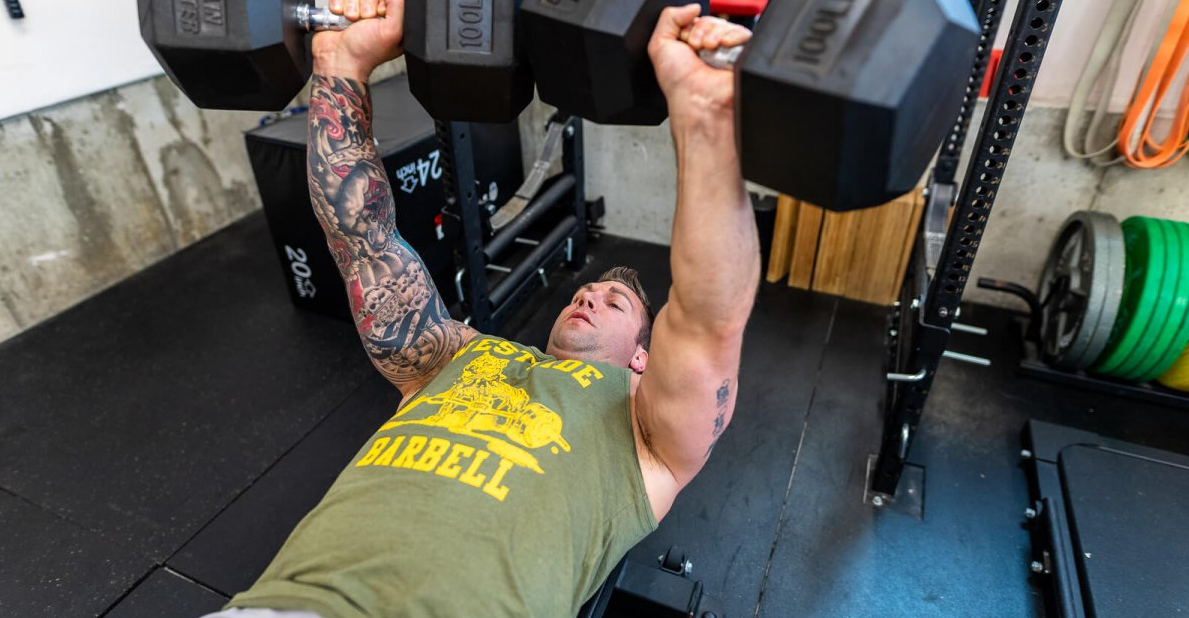
If you’re into lifting and powerlifting, floor press workouts can be a very beneficial exercise to add to your workout routine. One of the main causes behind a missed lift is a weak lockout. This is usually caused by your elbows being under a lot of tension.
If you want to improve your lockout, especially if you have longer arms, I wholeheartedly recommend the floor press.
Good for Sore Shoulders
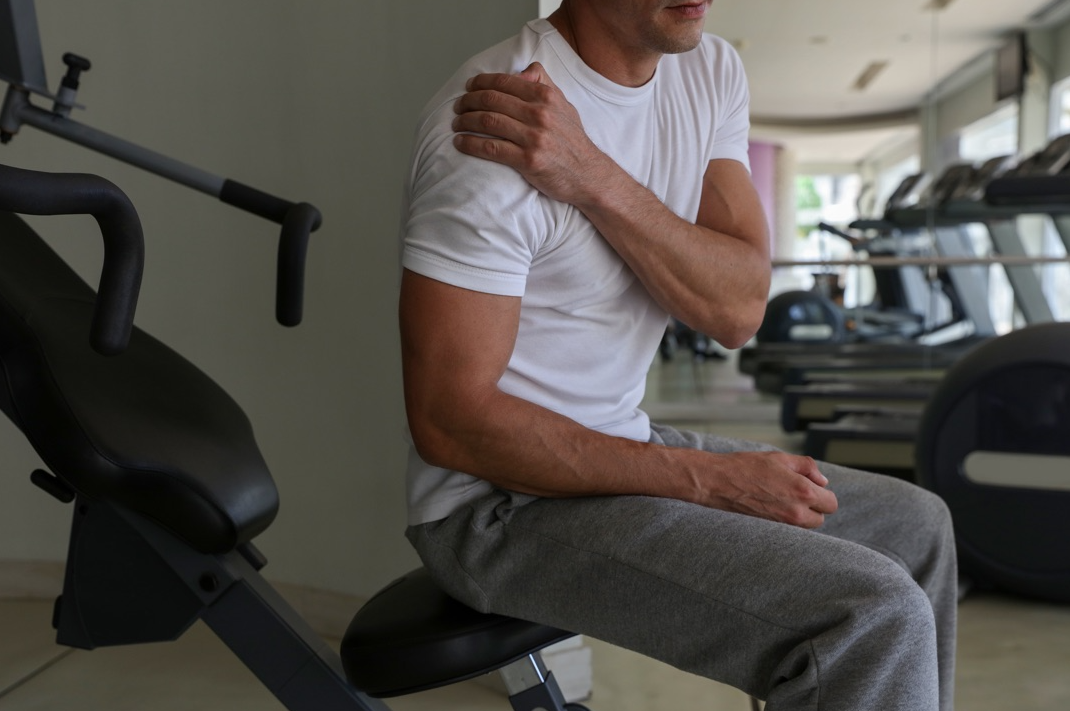
For those who have sore shoulders or are suffering from shoulder injuries, pressing movements can be a good alternative to the regular bench press. A dumbbell floor press doesn’t put nearly as much strain on your shoulder as a bench press, making it an ideal option for those with shoulder issues and need to expose their shoulder joint, or joints to less stress. The main workload will be on your arms and chest instead. This is why many also choose the chest press over the bench press because of the shorter and more controlled motion.
Good for Working Mid-Range Sticking Points
I mentioned earlier that the floor press is a good way of improving one’s lockout strength. Well, you can also use it to break through mid-range sticking points. I highly recommend pausing in the middle of each rep for a couple of seconds ensuring that your elbows touch. This will push you to generate force from a dead stop.
Increases Eccentric Control

When compared to the bench press, the floor press requires you to have much more control over the weights you’re lifting. Benching tends to instill a lot of habits that wouldn’t translate well, such as bouncing the barbell on your chest.
If you were to try and bounce the barbell during floor press work, you’ll smash your elbows on the floor and feel a lot of elbow pain. This is why you must bring down the weights in a slow, controlled motion and avoid bouncing.
Don’t be that guy that ego lifts just so they can try and look cool in front of the others in the gym. We all know that guy that benches more than he squats and is super un-proportional in size, trust me it does not look good.
Safer than Bench Pressing
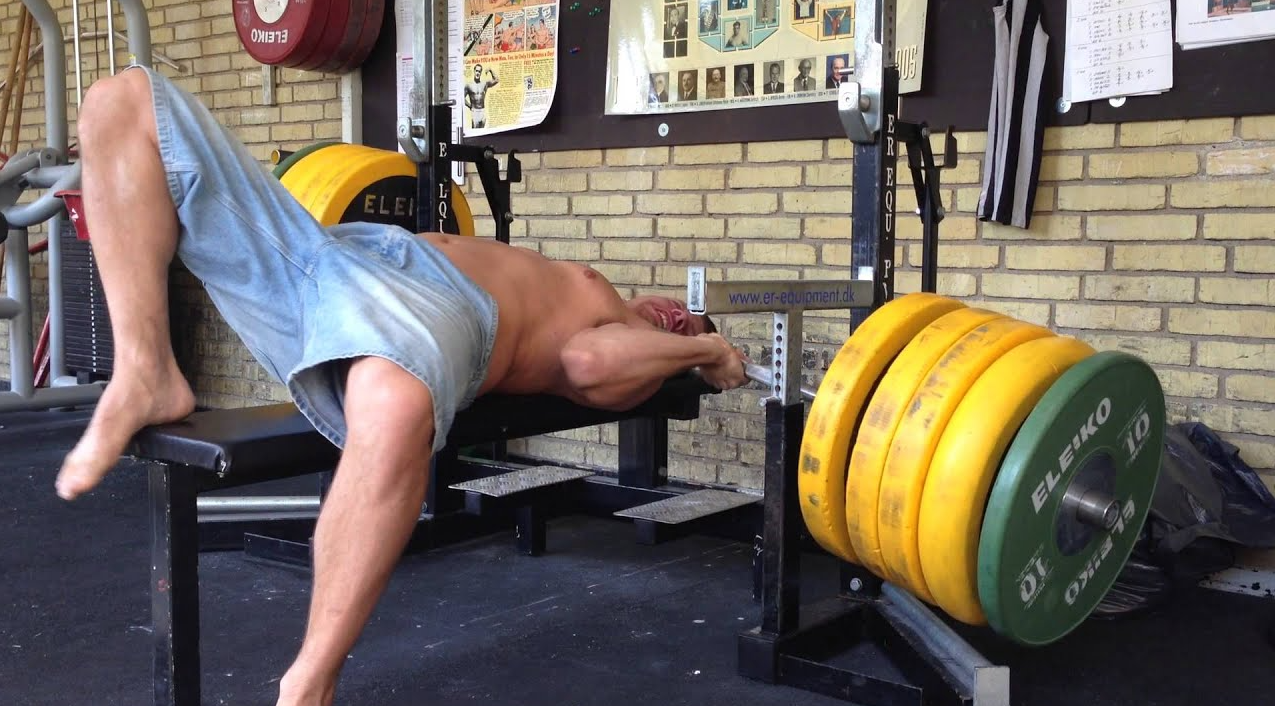
I’ve seen so many people who attempt to bench press heavy weights without having a spotter. I’ve even witnessed some accidents that happened because someone thought they had something to prove by not having a spotter and benching heavy loads.
The point is
My point here is that bench pressing can be dangerous, which is why it’s usually recommended to have a spotter with you, especially when you’re benching heavyweights. Floor presses are safer because even in the case where you can’t bring the weights back up, they’ll rest safely on the floor.
Dumbbell Floor Press: Common Mistakes
These are the most common mistakes that beginners make when they are first performing this exercise.
Bouncing the Weight
As I mentioned earlier, bouncing is something you can do when benching, but it’s not recommended when doing floor presses. The keyword here is control. You need to be in control of the weights at all times. The way I see it is that you’d be cheating yourself if you bounce the weights off.
Instead, lower the weights and pause for a moment before pushing them back up.
Flaring your Elbows Out
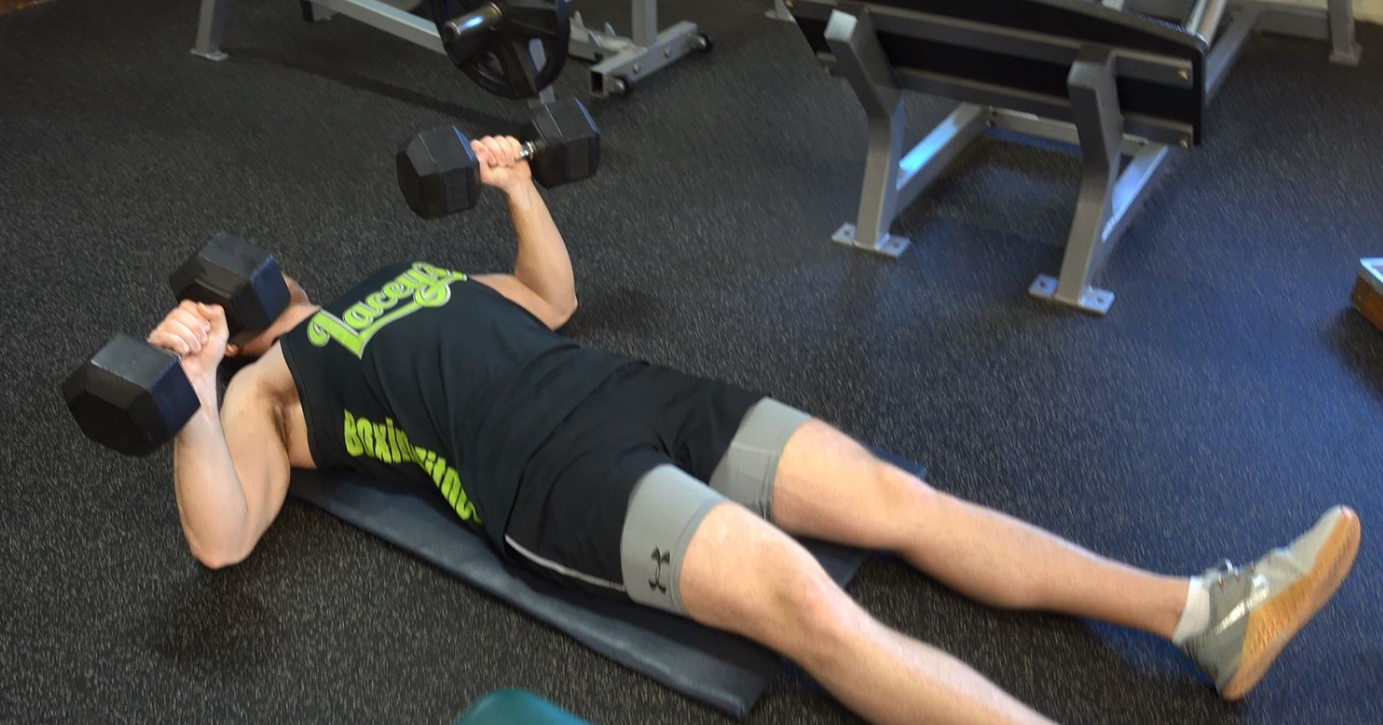
A common mistake people make when doing floor presses is that they flare their elbows out. It’s important to keep your elbows tucked by your sides at all times.
If you find yourself unintentionally flaring your elbows out, it’s probably due to the weights being too heavy. Flaring your elbows also increases the risk of shoulder injury since most of the tension will be placed on your shoulders instead of your chest.
If you’re struggling with this mistake, try to use lighter weights until you get a feel for the motion, and tucking your elbows by your sides becomes natural.
Lifting Too Light
One thing I see most people do is get comfortable with the weights they’re using and just keep training in the ten rep range and sometimes more. One thing that really helps you improve your performance is training fewer reps but using heavier weights to add mass.
Working out is all about finding your comfort zone and going beyond. A lot of people seem to forget the second part and only focus on the first, sticking to a desired number of reps and doing nothing about the weight.
Dumbbell Floor Press Alternatives
Here are the most common alternative exercises that you can substitute in for the dumbbell floor press.
Bench Press
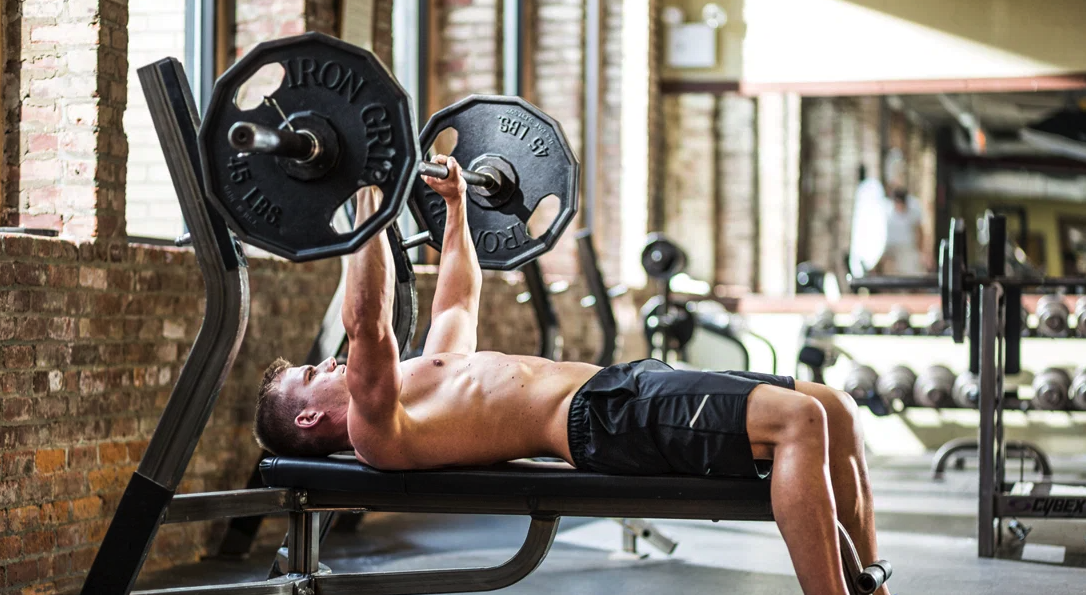
You’ve already heard me talk about the bench press many times and compare it to the floor press. Both exercises share a lot of similarities. Benching is very popular among bodybuilders and powerlifters. Almost every workout you’ll find will incorporate the bench press as a chest exercise.
A classic exercise
It is especially sacred among powerlifters. It’s known as one of the big three lifts, the other two big lifts being the deadlift and the squat. For me I actually prefer the smith machine squat and the smith machine deadlift for the exact reason that I prefer this exercise over bench press.
As for athletes, a one-rep max on bench press can accurately indicate court/field performance. When it comes to bodybuilders, it’s a fundamental exercise that aims to build strength on the upper body muscle groups.
Benching basically strengthens your pecs and your chest in general. You’ll also be building up your triceps and shoulders.
How to Do Bench Press
- Lie down on a bench and put your hands just outside of the shoulder width.
- Pinch your shoulder blades together and drive them into the bench.
- Breathe in and let your spotter help you lift off the weight of the bench press bar so you can maintain tightness through your upper back.
- Let the weight settle and make sure the top half of your back stays tight after the lift-off.
- Breathe in and slowly let the bar down by unlocking your elbows
- Lower the bar in a straight line towards the base of the sternum until it touches the best.
- Push the bar back up in a straight line by pressing into the bench, pressing your feet flat on the floor and extending your elbows.
- Rinse and repeat until you finish your set.
Bench Press Video Illustration
Tips
- Focus on your technique. Once you’ve got it nailed down, you can move on to benching heavier loads.
- Keep the bar aligned with your wrist and elbows, so it travels in a straight line. Position the bar as ow in your palm as you can while still being able to wrap the thumb around it so you can keep your wrist straight.
- As you let the bar descend, aim for your sternum or slightly below it so that the bar goes in a straight line.
- Don’t let your wrists roll back into extension. Instead, roll your knuckles toward the ceiling.
- Make sure the bar touches your chest in each rep. You can look into board presses or use chains or bands if you want to overload specific ranges of motion.
Inclined Barbell Bench Press

Not unlike the bench press, the inclined barbell bench press is an exercise that works the upper body strength. This exercise focuses more on the upper region of the best. It’s also safer and more joint-friendly for your shoulders.
How to Do Incline Barbell Bench Press
- Position yourself on an incline bench with a 30-45 degree angle. Grab the barbell with an overhand grip and with your hands being shoulder-width apart and hold it above your chest. Now, extend your arms and the weight upwards and lock your elbows.
- Lower the bar down slowly. When the bar reaches your best, pause for a moment then press it back up to the starting position in a straight line.
Inclined Barbell Bench Press Video Illustration
Tips
- Avoid lowering the bar to the neck. Bring it to the upper part of your chest when it’s descending.
- Don’t overextend your neck so that you remain in a neutral long spine position.
- Don’t bounce the bar off your chest. Instead, bring it down in a controlled and slow motion.
Chest Dips
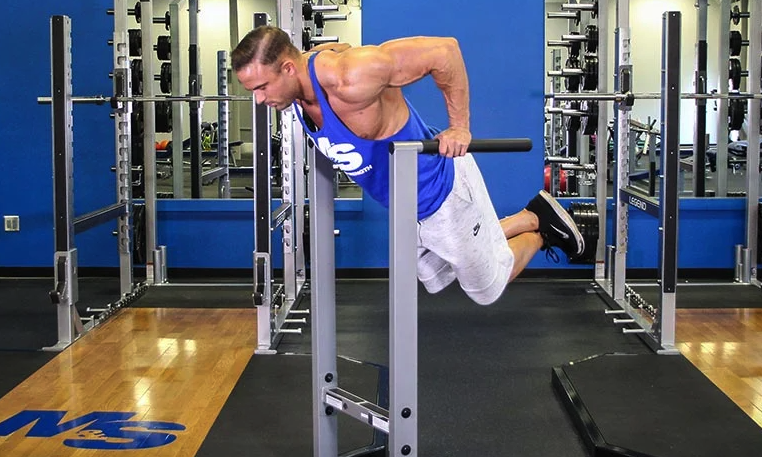
This is a great exercise if you want to work on your upper body muscle groups. It’s especially great for hitting the lower part of the pecs and your triceps. It works in a similar way to the decline bench press but follows a vertical pressing movement pattern instead.
How to Do Chest Dips
- If possible, step up on the dip station and put your hands in position just like you would a neutral grip pull up.
- Begin the dip by unlocking your elbows and lowering your body slowly until your forearms are almost parallel with the floor.
- Drive back up to the starting position by using your palms to push through.
- Rinse and repeat until you finish your set.
Chest Dips Video Illustration
Tips
- There are two different ways of doing chest dips:
- Make your sure you stay upright and keep your elbows in close, so you work your triceps more.
- Lean forward with your elbows being wider if you want to focus on your chest more.
- In order to avoid excessive spinal movement, keep your legs straight down while bracing the abs and glutes.
- If you don’t have access to a dip station, you can simply put a box underneath the handles instead.
- If you don’t have a box, just jump into position.
- Make sure your head doesn’t stick out when you’re descending.
- Make sure your elbows stay short of lockout. This will keep the tension on your triceps.
- If you’re not comfortable with your grip, you can try a false grip and wrap your thumb over the bar.
Weighted Push-Ups
With Bands
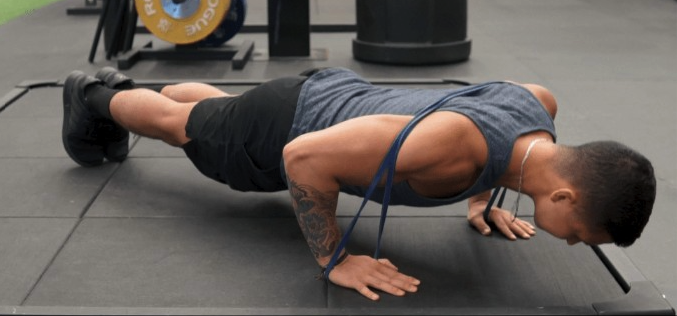
With Weight Plates
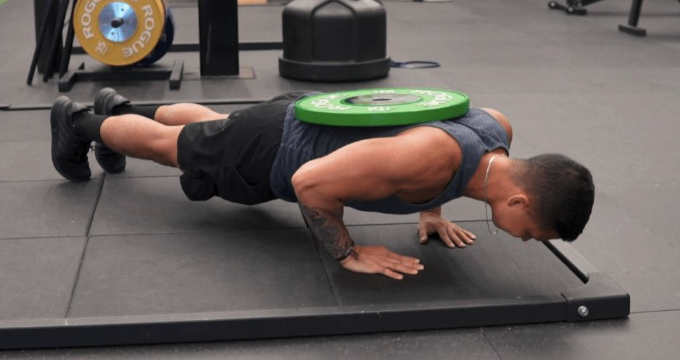
Push-ups are already an excellent exercise that works the chest, shoulders, and triceps.
However, if you can do them easily, then you won’t be able to build more muscle mass anymore.
That’s where the weights come in to solve the issue. I recommend staying in the 6-12 rep range if you want to build muscle mass efficiently.
Weighted push-ups are done by placing weight plates on your upper back. However, it can be awkward and uncomfortable, so it’s vital to have someone to help you load and unload the weight plates.
How to Do Weighted Push-Ups
- The best way to load the weights on your back is to use a dipping belt.
- For the dip belt to be effective, it’s best to have some clearance from the ground.
- Pay attention to where you position the load as it’s very important to avoid injury.
Weighted Push-Ups Video Illustration
Related Readings:
- Dumbbell Pullover Exercise Guide
- Shoulder Press Machines
- Rear Delt Row: How to Do it, Variations, Muscles Worked, Benefits, Alternative Exercises
- T Bar Row Exercise Guide – How To, Muscles Worked, Alternatives, Mistakes to Avoid
- Underhand Dumbbell Rows
- Underhand Front Raise – What It Is, How To Do It, Muscles Worked, And Alternatives Exercises
References:
- https://www.bodybuilding.com/content/the-floor-press-what-makes-the-floor-press-so-special.html
- https://www.t-nation.com/training/master-the-floor-press
Ben Mayz
Hi there! I'm Ben, main author and chief editor at Fitlifefanatics.com. I have been obsessed with Strength Training and Fitness for 18 years now.
My passion for living a happy fit lifestyle is what made me realize that fitness is what I wanted for my future.
I went on to earn my Masters in Sports Training & Biomechanics.
My passion for Strength training & fitness and my love of helping others is what made me start Fitlifefanatics.
Here, myself, and a team of specialist aim to provide the most accurate, and actionable information possible in hopes to help foster the fitness community forward.
You can learn more about Fitlifefanatics on our About Page
